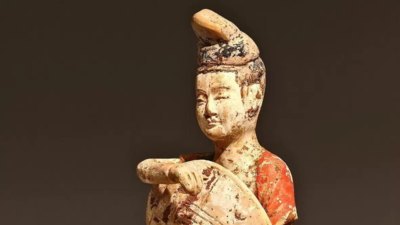LONDON: Historian William Dalrymple has criticised an exhibition at the British Museum featuring over 300 objects from the Silk Roads from CE 500 to CE 1000 for excluding India.
Speaking to TOI from London after visiting the show, Dalrymple said he was shocked India was excluded given that India was the “biggest trading partner where East-West trade took place” during this period.
The exhibition “Silk Roads”, which opened last week, claims to “challenge the popular concept of the Silk Road as a single trade route, instead showing how the Silk Roads were made up of overlapping networks.”
“Hanging from the ceiling in a single corridor are various location names — it covers almost all of Asia, except India, and it seems so bizarre, because India was the largest trading partner of the Roman empire,” the author said.
“When you are trying to present the trade routes of the ancient world and do all the minor sites of international trade and miss out the biggest trading partner where east-west trade took place in its greatest quantity, it is bizarre, particularly when you open the exhibition with a Buddha from Swat and end with a purse containing Rajasthani garnets,” he said.
“They acknowledge these garnets, but there is no display for India which should be at the heart of the show. It ends up being a bizarre omission, almost inexplicable, to anyone that knows the centrality of India to ancient trade networks,” he added, pointing out not one Roman coin horde has ever been found in China, yet Roman coin hordes are found in India every year.
India was the greatest trading partner with Rome of the classical world, while China and Rome had only the very faintest impression of each other’s existence, Dalrymple said.
This is a theme of his book, “The Golden Road”, in which he argues this notion of an East-West overland route linking China with the Mediterranean, the so-called Silk Road, is a myth which grew out of a Sino-centric reframing of history. “Silk was not even the biggest product imported from the East; pepper from India was,” he said.
“India has a haunting presence throughout the exhibition,” Dalrymple said.
Buddhism is a central feature, even if the exhibition misses out the home of Buddhism, India.
“Nalanda doesn’t feature at all,” he said. “Yet this was the period when the Buddhist monks were coming from Japan and China to Nalanda.”
A spokesperson for the British Museum said: “We don’t recognise the characterisation made by Dalrymple. The exhibition goes beyond the narrow 19th-century definition of the Silk Road to present a richer, more complex story of the Silk Roads as overlapping networks.”
“Maps in the exhibition and accompanying book also refer to sites from India. For instance, a map showing the probable route of the 9th century ship that sank off the coast of Indonesia, near the island of Belitung, recognises that the vessel most likely stopped at ports along the coast of the Indian subcontinent,” the spokesperson said, adding, “Objects featured throughout the exhibition point to the importance of India in the trade of goods and the transmission of knowledge.”
“The game of chess is noted as an invention in India probably around 500 CE and is represented by the world’s oldest group of chess pieces, made from elephant ivory probably sourced from India,” the spokesperson said.
